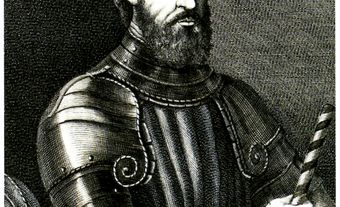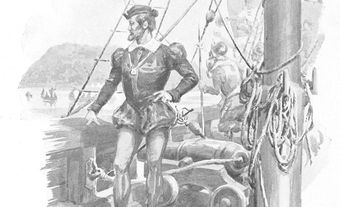
Early Years in Venice
John Cabot had a complex and shadowy early life. He was probably born before 1450 in Italy and was awarded Venetian citizenship in 1476, which meant he had been living there for at least fifteen years. People often signed their names in different ways at this time, and Cabot was no exception. In one 1476 document he identified himself as Zuan Chabotto, which gives a clue to his origins. It combined Zuan, the Venetian form for Giovanni, with a family name that suggested an origin somewhere on the Italian peninsula, since a Venetian would have spelled it Caboto. He had a Venetian wife, Mattea, and three sons, one of whom, Sebastian, rose to the rank of pilot-major of Spain for the Indies trade. Cabot was a merchant; Venetian records identify him as a hide trader, and in 1483 he sold a female slave in Crete. He was also a property developer in Venice and nearby Chioggia.
Cabot in Spain
In 1488, Cabot fled Venice with his family because he owed prominent people money. Where the Cabot family initially went is unknown, but by 1490 John Cabot was in Valencia, Spain, which like Venice was a city of canals. In 1492, he partnered with a Basque merchant named Gaspar Rull in a proposal to build an artificial harbour for Valencia on its Mediterranean coast. In April 1492, the project captured the enthusiasm of Fernando (Ferdinand), king of Aragon and husband of Isabel, queen of Castille, who together ruled what is now a unified Spain. The royal couple had just agreed to send Christopher Columbus on his now-famous voyage to the Americas. In the autumn of 1492, Fernando encouraged the governor-general of Valencia to find a way to finance Cabot’s harbour scheme. However, in March 1493, the council of Valencia decided it could not fund Cabot’s plan. Despite Fernando’s attempt to move the project forward that April, the scheme collapsed.
Cabot disappeared from the historical record until June 1494, when he resurfaced in another marine engineering plan dear to the Spanish monarchs. He was hired to build a fixed bridge link in Seville to its maritime centre, the island of Triana in the Guadalquivir River, which otherwise was serviced by a troublesome floating one. Though Columbus had reached the Americas, he believed he had found land on the eastern edge of Asia, and Seville had been chosen as the headquarters of what Spain imagined was a lucrative transatlantic trade route. Cabot’s assignment thus was an important one, but something went wrong. In December 1494, a group of leading citizens of Seville gathered, unhappy with Cabot’s lack of progress, given the funds he had been provided. At least one of them thought he should be banished from the city. By then, Cabot probably had left town.
Cabot in England
Following the demise of Cabot’s Seville bridge project, the marine engineer again disappeared from the historical record. In March 1496 he resurfaced, this time as the commander of a proposed westward voyage under the flag of the King of England, Henry VII. Although there is no documentary proof, during Cabot’s absence from the historical record, between April 1493 and June 1494, he could have sailed with Columbus’s second voyage to the Caribbean. Most of the names of the over 1,000 people who accompanied Columbus weren’t recorded; however, Cabot could have been among the marine engineers on the voyage’s 17 ships who were expected to construct a harbour facility in what is now Haiti. Had Cabot been present on this journey, Henry VII would have had some basis to believe the would-be Venetian explorer could make a similar voyage to the far side of the Atlantic. It would help explain why Henry VII hired Cabot, a foreigner with a problematic résumé and no known nautical expertise, to make such a journey.
On 5 March 1496, Henry awarded Cabot and his three sons a generous letters patent, a document granting them the right to explore and exploit areas unknown to Christian monarchs. The Cabots were authorized to sail to “all parts of the eastern, western and northern sea, under our banners, flags and ensigns,” with as many as five ships, manned and equipped at their own expense. The Cabots were to “find, discover and investigate whatsoever islands, countries, regions or provinces of heathens and infidels, in whatsoever part of the world placed, which before this time were unknown to all Christians.” The Cabots would serve as Henry’s “vassals, and governors lieutenants and deputies” in whatever lands met the criteria of the patent, and they were given the right to “conquer, occupy and possess whatsoever towns, castles, cities and islands by them discovered.” With the letters patent, the Cabots could secure financial backing. Two payments were made in April and May 1496 to John Cabot by the House of Bardi (a family of Florentine merchants) to fund his search for “the new land,” suggesting his investors thought he was looking for more than a northern trade route to Asia.
First Voyage (1496)
Cabot’s first voyage departed Bristol, England, in 1496. Sailing westward in the north Atlantic was no easy task. The prevailing weather patterns track from west to east, and ships of Cabot’s time could scarcely sail toward the wind. No first-hand accounts of Cabot’s first attempt to sail west survive. Historians only know that it was a failure, with Cabot apparently rebuffed by stormy weather.
Second Voyage (1497)
Cabot mounted a second attempt from Bristol in May 1497, using a ship called the Matthew. It may have been a happy coincidence that its name was the English version of Cabot’s wife’s name, Mattea. There are no records of the ship’s individual crewmembers, and all the accounts of the voyage are second-hand — a remarkable lack of documentation for a voyage that would be the foundation of England’s claim to North America.
Historians have long debated exactly where Cabot explored. The most authoritative report of his journey was a letter by a London merchant named Hugh Say. Written in the winter of 1497-98, but only discovered in Spanish archives in the mid-1950s, Say’s letter (written in Spanish) was addressed to a “great admiral” in Spain who may have been Columbus.
The rough latitudes Say provided suggest Cabot made landfall around southern Labrador and northernmost Newfoundland, then worked his way southeast along the coast until he reached the Avalon Peninsula, at which point he began the journey home. Cabot led a fearful crew, with reports suggesting they never ventured more than a crossbow’s shot into the land. They saw two running figures in the woods that might have been human or animal and brought back an unstrung bow “painted with brazil,” suggesting it was decorated with red ochre by the Beothuk of Newfoundland or the Innu of Labrador. He also brought back a snare for capturing game and a needle for making nets. Cabot thought (wrongly) there might be tilled lands, written in Say’s letter as tierras labradas, which may have been the source of the name for Labrador. Say also said it was certain the land Cabot coasted was Brasil, a fabled island thought to exist somewhere west of Ireland.
Others who heard about Cabot’s voyage suggested he saw two islands, a misconception possibly resulting from the deep indentations of Newfoundland’s Conception and Trinity Bays, and arrived at the coast of East Asia. Some believed he had reached another fabled island, the Isle of Seven Cities, thought to exist in the Atlantic.
There were also reports Cabot had found an enormous new fishery. In December 1497, the Milanese ambassador to England reported hearing Cabot assert the sea was “swarming with fish, which can be taken not only with the net, but in baskets let down with a stone.” The fish of course were cod, and their abundance on the Grand Banks later laid the foundation for Newfoundland’s fishing industry.
Third Voyage (1498)
Henry VII rewarded Cabot with a royal pension on December 1497 and a renewed letters patent in February 1498 that gave him additional rights to help mount the next voyage. The additional rights included the ability to charter up to six ships as large as 200 tons. The voyage was again supposed to be mounted at Cabot’s expense, although the king personally invested in one participating ship. Despite reports from the 1497 voyage of masses of fish, no preparations were made to harvest them.
A flotilla of probably five ships sailed in early May. What became of it remains a mystery. Historians long presumed, based on a flawed account by the chronicler Polydore Vergil, that all the ships were lost, but at least one must have returned. A map made by Spanish cartographer Juan de la Cosa in 1500 — one of the earliest European maps to incorporate the Americas — included details of the coastline with English place names, flags and the notation “the sea discovered by the English.” The map suggests Cabot’s voyage ventured perhaps as far south as modern New England and Long Island.
Cabot’s royal pension did continue to be paid until 1499, but if he was lost on the 1498 voyage, it may only have been collected in his absence by one of his sons, or his widow, Mattea.
Aftermath
Despite being so poorly documented, Cabot’s 1497 voyage became the basis of English claims to North America. At the time, the westward voyages of exploration out of Bristol between 1496 and about 1506, as well as one by Sebastian Cabot around 1508, were probably considered failures. Their purpose was to secure trade opportunities with Asia, not new fishing grounds, which not even Cabot was interested in, despite praising the teeming schools. Instead of trade with Asia, Cabot and his Bristol successors found an enormous land mass blocking the way and no obvious source of wealth.

 Share on Facebook
Share on Facebook Share on X
Share on X Share by Email
Share by Email Share on Google Classroom
Share on Google Classroom


